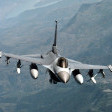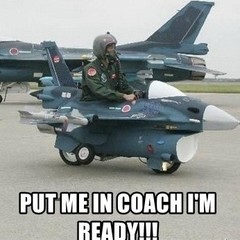-
Posts
792 -
Joined
-
Last visited
-
Days Won
2
Personal Information
-
Flight Simulators
DCS, BMS, X-Plane 11
-
Location
Sweden
-
Interests
Flight sims, submarine sims and anything that has to do with music. I also enjoy copulation.
-
Occupation
Engineering Physics Student / Disgruntled F-16 Enthusiast
Recent Profile Visitors
The recent visitors block is disabled and is not being shown to other users.
-
This is incorrect. The block and tape of F-16 that is modeled in DCS indeed doesn't support SADL, but it supports full 9-line text messages and CAS IP/TGT steerpoints to be received via IDM.
-
Nope, and it's not on the roadmap either.
-
The important thing to emphasize in regards to the AN/ALR-56M in DCS is that it is not really an issue of evidence or documentation, but of interpretation. As I mentioned, the DCS F-16C manual was correct in the way it described the functionality of the AN/ALR-56M, but the way it was implemented in-game was based on an incorrect interpretation of that information. I'll look into writing a bug report on it when time allows.
-
Nope, it is still incorrectly implemented, yet bug reports about it are marked "correct-as-is" in the DCS F-16C bug section. I've been thinking about writing a full length bug report regarding the AN/ALR-56M, but I honestly don't know what difference it'd make. Feels like kicking water uphill at this point. I actually gave praise to the DCS F-16C manual in an old post I made (linked below) for correctly describing the AN/ALR-56M's functionality, even though it had been incorrectly implemented in-game. However, ED has since rewritten and removed certain sections, words and illustrations from the DCS F-16C manual regarding the AN/ALR-56M, so that the manual better describes the current incorrect implementation, rather than fixing the AN/ALR-56M's in-game implementation so that it matched both the DCS and real world manuals. I think it's quite clear at this point, based on ED's actions, that their intention is to leave the AN/ALR-56M as-is.
-
Well, as I wrote in my post which @Wing linked to (I really appreciate all the positive attention my post has gotten from the DCS community), there are so many systems which are either bugged or completely missing, which are not mentioned in the roadmap. 95% of all the things I mentioned in my post are not DCS core features, but rather specific to the F-16C. Just to pick the most glaring example in my post, which I put at the top for that exact reason: we do not have a damage model. Detaching wings and control surfaces, fuel leaks, and pilot death. That's pretty much the only damage which is simulated in the DCS F-16C. This is in stark contrast to other DCS products where almost every individual subsystem can actually fail due to combat damage, but for some reason, this was never implemented in the DCS F-16C, even though it was advertised as a feature on the product page. In fact, here are the 3 top listed "Key Features" on the DCS F-16C product page: Authentic fly-by-wire Flight Control System (FCS). The most realistic model of the F-16C imaginable, down to each bolt and flake of paint, animated controls surfaces, lights, damage model, and landing gear. Detailed simulation of the Viper’s engines, fuel, electrical, hydraulic, comms, lighting and emergency systems and many more. None of these bullet points have been fulfilled, and they are not mentioned in the roadmap. Does this mean that the items mentioned on the DCS product page are not what customers can actually expect at full release? Because that looks a lot like false advertising in my eyes. And if ED intends on rectifying many of the issues I listed in my post, plus many of the issues I didn't mention in my post, why are they not mentioned in the DCS F-16C roadmap? And why can't these issues be fixed without forcing the DCS F-16C out of early access prematurely? Having the DCS F-16C pushed out of early access kind of implies that all the "Key Features" on the product page are included in the product, does it not? It will be extremely misleading to potential customers who read the product page and believe that they will get all the listed "Key Features" as the DCS F-16C would, at least in name, be out of early access? Not to mention all the people who bought the DCS F-16C over the last 5 years in good faith, assuming that the "Key Features" listed on the product page would actually be featured in the final product. As I finished off my linked post by asking, is this the new baseline we can expect from ED products, if the DCS F-16C is released in its current state + Sniper ATP? I don't know if you actually fly the DCS F-16C anything in your spare time, but to be completely honest with you, it really is in a sorry state, and progress has been moving at a snails pace for years now. Out of all the issues which I mentioned in my over a year old post now, pretty much nothing has been rectified. I don't know why I'd believe any of that would change after early access is over for this product?
- 23 replies
-
- 25
-

-

-
There is a VSD (Vertical Situation Display) page in the F-35 which will actually show your ownship RCS in real time in relation to threats, as knowing your ownship RCS characteristics is pretty pretty important for stealth based tactics and remaining undetected. With the current RCS implementation in DCS where it's basically just a flat value, the F-35 in particular will either be given a very low RCS value and be undetectable at a lot of distances and aspects where it shouldn't be, or it'll be given a higher RCS value and be detectable at distances and aspects it shouldn't be. This is why DCS needs a polar RCS model, where aircraft will actually have different RCS depending on aspect, both for stealth and non-stealth aircraft, and you can find tonnes of studies online on RCS and aspect, with both experimental and simulated tests on many different airframes, which can be used as a starting point. For example, in a combat scenario where the enemy has multiple aircraft coming at an F-35 from many different directions, where they might have multiple ground based air search radars in different locations, especially when information is shared between these assets via datalink, it might actually make it quite difficult or even impossible for an F-35 to operate undetected and greatly decrease its advantage against inferior aircraft, leveling the playing field. A DCS F-35 pilot would actually have to use planning, tactics and pick his battles in order to retain all the advantages that stealth provides. Without proper RCS modelling in DCS, the F-35 will probably just steamroll everything in every single scenario regardless of the skill and tactics of its pilot. You can see the VSD in action in Military History Visualized's video where he flies an F-35 simulator at some airshow: https://www.youtube.com/watch?v=88vCjQ8fCb0 Normal configuration: During missile launch with weapon bay doors open:
-
phyrBlaine started following WHOGX5
-
When putting the FMU-152 tail fuze on the Mk-84 High Drag variant, the minimum arming delay is 2 seconds. However, if I put the same FMU-152 tail fuze on an Mk-84 Low Drag variant, for some reason the minimum arming delay is 4 seconds.
-
As per real world manuals as well as Wags own description in the DTC video which was released yesterday, the DTC page labels should only invert while a data transfer corresponding to that label is in progress, and then return to normal once the data transfer corresponding to that label has been completed. Currently, the label stays inverted indefinitely. You can see the DTC page in an older block of F-16C function in the same way here at 2:44.
- 1 reply
-
- 8
-

-

not a bug INS alignment stops when throttling up.
WHOGX5 replied to Lookiss's topic in Bugs and Problems
Well, I'll extend an olive branch and say that he is partially correct. You have to remain stationary until the RDY indication is either flashing or solid, which will happen long before the alignment process is finished. After that you can move around freely, as the aircraft will automatically pause the alignment process while you're moving, and then automatically resume the alignment when stationary again. For a huge part of the alignment process, you can therefore move around freely. For a small part of it, you have to remain fully stationary. -

not a bug INS alignment stops when throttling up.
WHOGX5 replied to Lookiss's topic in Bugs and Problems
DM sent. -

DCS F-16C Early Access, what's left, what's next.
WHOGX5 replied to RyanR's topic in DCS: F-16C Viper
Thank you, much appreciated! -

not a bug INS alignment stops when throttling up.
WHOGX5 replied to Lookiss's topic in Bugs and Problems
This is incorrect. As soon as either a steady or flashing RDY is displayed on the INS page, you should be able to move your aircraft freely as it will automatically enter AUTO NAV mode, even with your INS knob set to STOR HDG or NORM. It doesn't matter if you're spooling up your engine, or you decide to taxi to the other side of the airfield, the alignment should not break. Then, once stationary again, the INS will automatically resume the alignment process without any actions from the pilot. The INS switch should only need to be set to NAV before takeoff, as AUTO NAV will only work on the ground. In fact, using these kinds of interrupted alignments should actually increase INS accuracy below 10, but this doesn't happen currently in the DCS F-16C either. -
No, it wouldn't be ALOT of work. We're not talking about some complex full body animations here, where they need to hire a motion capture studio and then have a whole team of animators sit for weeks on end adjusting and finetuning the animations. We're talking about moving the arm from the throttle or stick, and lifting it up in the air. That's it, an animation which could be created by hand, probably in about an hour of work by a professional who knows what they're doing. Of course I don't know how the DCS engine handles animations and how hard it'd be to add, maybe it's a super complex and convoluted process compared to other game engines, but normally this would be quite a menial task to include in a game. Also, similar animations already exist in other ED modules, like the F/A-18C pilot body grabbing the canopy rail handle during the catapult launch. If they can do it in the F/A-18C, I don't see why they couldn't make the same thing for the F-16C? You'd just make the animation be triggered by the mouse cursor being in a specific region of the cockpit, rather than when triggering a catapult launch. And of course, this feature would benefit from being added to all DCS modules as they all could benefit from the physical pilot body not being a hindrance and an obstacle to operating your aircraft.
-

DCS F-16C Early Access, what's left, what's next.
WHOGX5 replied to RyanR's topic in DCS: F-16C Viper
There has been quite a few messages since my last reply, and it feels like some people in this thread think I mention all the systems I did in my post merely because I want to sit and LARP useless features, and I can tell you that this is definitely not the case. All the items I've mentioned have a direct impact on the combat effectiveness of the DCS F-16C, as well as the user experience. That is why I mentioned the things I did. As it stands currently, the DCS F-16C is unable to employ most real world tactics due to there being so many missing or inoperative systems, and its performance in combat is therefore very lackluster. It doesn't matter if you're doing BVR, WVR, SEAD, AI, or just hurling some bombs on a target. There's always several aspects of this aircraft that's missing or not working correctly, limiting your combat effectiveness in each of these roles. In my post I also put special emphasis on the SEAD role as, after all, this is the primary role of the F-16CM-50, and the DCS F-16C's performance in this role is woefully inadequate. You also have to remember that the combat environment we have in DCS is quite dated and sterile. In the 2007-era which the DCS F-16C is based on, you'd have much more capable weapon systems to face off against, which for the SEAD role would include things like both datalinked and home-on-jam SAM missiles, integrated air defense networks with intelligent and coordinated SAM operators, GPS and communications jamming, ground based radar decoys, etc. That is why I really appreciate when ED models things in depth, like the INS and its fix functions as well as GPS reception, which now enables the future addition of things like GPS jamming, which is a staple of modern warfare that even civilian aircraft and airliners have to contend with on a daily basis. And if we get GPS jamming, this also highlights one aspect of why the Digital Terrain System is important, as it, amongst many other things, increases the INS accuracy over topographically varied terrain. And all of a sudden, this has ripple effects into mission planning, where you might choose to ingress towards a target over more rugged terrain if you expect to encounter GPS jamming in order to maintain higher INS accuracy, rather than ingressing over the flat desert or ocean and having to do manual INS fixes, or it might affect which weapons you choose to employ, opting for LGB's instead of JDAMs, or it encourages you to actually make use of Offset Aimpoints or VRP/VIPs when engaging targets, et cetera. Just with the addition of a few systems, it makes the experience so much deeper, and it also gives you very good reasons to learn your aircraft more in-depth and to actually make use all the functions that have already been implemented into this product to their full potential. And for those who mainly want to hop in their jet, fly out to the range in a sterile environment, and drop some bombs on targets to blow off some steam after a hard days work, they can still do that. But it also allows people to get so much more out of the product, to get more invested into DCS as a platform, to increase customer retention, and in the end increasing future revenue for ED. These dedicated people who go in-depth are also usually the ones who creates a lot of content which benefits the entire community, stuff like tutorials, complex missions and campaigns, video content, etc., which entices new customers to join the fray and turns their toe dipping in DCS into a full submersion. And certain items I mentioned, like having a damage model, doesn't increase combat effectiveness, but it is of course an important aspect of combat. As it is right now in the DCS F-16C, the "damage model" is basically a big boolean. Either you audibly hear things hitting your aircraft, but not a single system is affected, or you die. Compared to other ED airframes, like the DCS A-10C or DCS F/A-18C, those modules actually model individual systems getting damaged, and you might actually end up utilizing emergency and backup systems to limp your jet back to base, and you might actually need to use your knowledge about how the fuel, hydraulic and electrical systems work in order to survive such an ordeal, isolate busted fuel lines, circumvent broken systems and components, etc. So when people claim the DCS F-16C has a damage model, that is simply not true because none of these things exist in what we currently have.- 141 replies
-
- 41
-

-

-

DCS F-16C Early Access, what's left, what's next.
WHOGX5 replied to RyanR's topic in DCS: F-16C Viper
As I mentioned in my previous reply, there is no way that ED does not have documentation on these things. If they didn't have the relevant manuals, they wouldn't have gotten as far as they have in modelling an F-16CM-50 M4.2+. I feel like the "no documentation" or "its classified" is often used to avoid responsiblitity, and I've even heard of people reporting issues referencing old manuals which are definitely in the public domain, and they still get told that they're not usable due to classification or similar.







